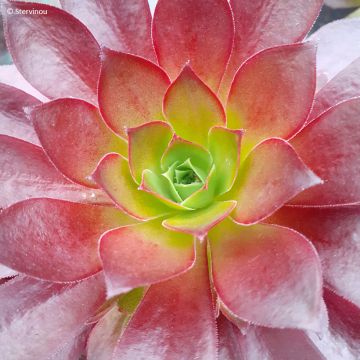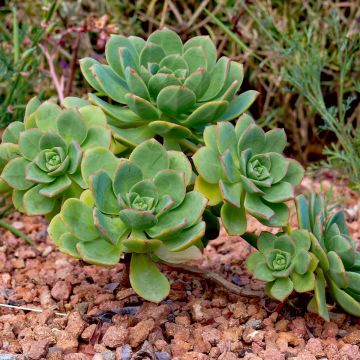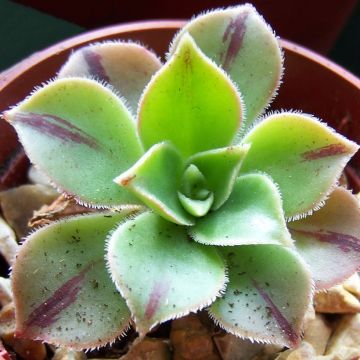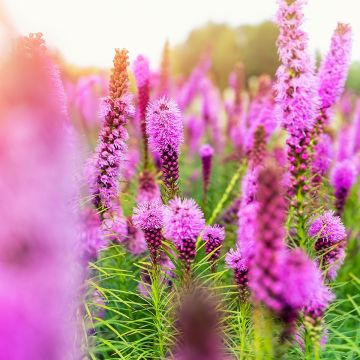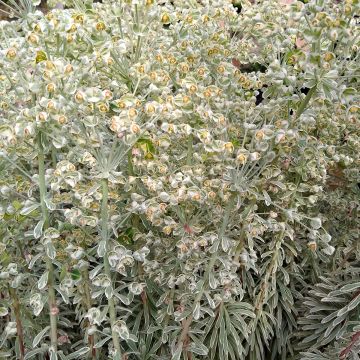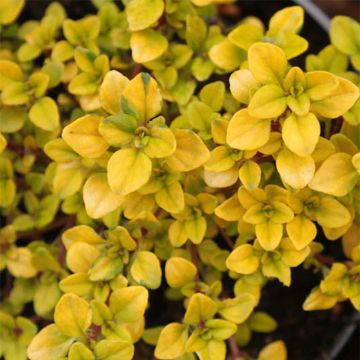

Aeonium arboreum Garnet - Aeonium en arbre
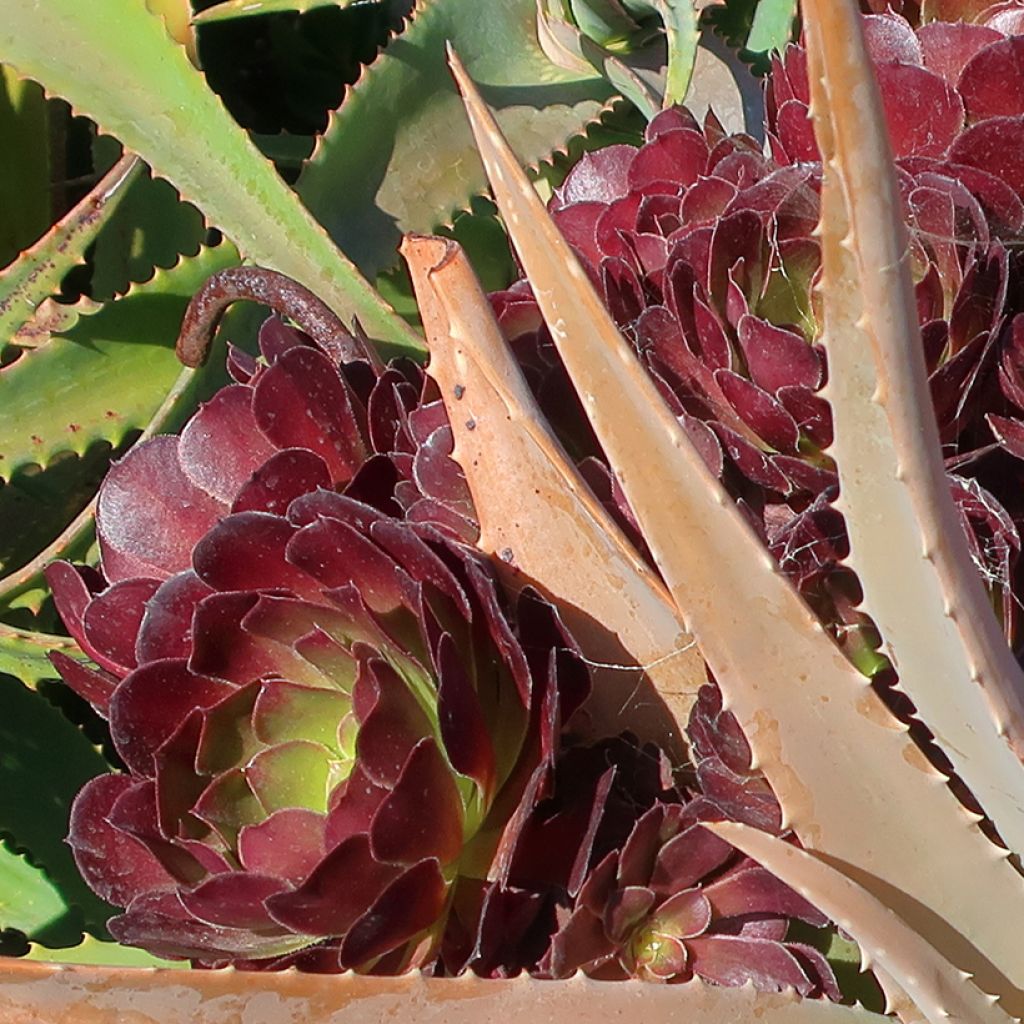

Aeonium arboreum Garnet - Aeonium en arbre


Aeonium arboreum Garnet - Aeonium en arbre


Aeonium arboreum Garnet - Aeonium en arbre
Aeonium arboreum Garnet
Aeonium arboreum Garnet
Tree Houseleek
Lovely plant, arrived in very good condition, I recommend this website.
Montserrat , 10/10/2024
This item cannot be shipped to the selected country
Delivery charge from €5.90
More information
Schedule delivery date,
and select date in basket
This plant carries a 24 months recovery warranty
More information
We guarantee the quality of our plants for a full growing cycle, and will replace at our expense any plant that fails to recover under normal climatic and planting conditions.
From €5.90 for pickup delivery and €6.90 for home delivery
Express home delivery from €8.90.

Does this plant fit my garden?
Set up your Plantfit profile →
Description
Aeonium arboreum 'Garnet' is a highly decorative horticultural hybrid, whose name immediately announces the colour of its foliage. The rosettes are predominantly garnet, especially when the plant is placed in a very sunny location. The centre remains green, creating a pleasant contrast, especially when the small yellow flowers appear in spring, standing out against the darker foliage. This moderate-sized succulent plant has a geometric and graphic appearance. Aeonium 'Garnet' grows in most soils, from acidic to moderately calcareous, as long as they are well-drained. It is frost-sensitive and should be overwintered practically everywhere in France or protected in milder climates.
Aeoniums are succulent plants of the Crassulaceae family, which includes about 1500 species, many of which have ornamental value. Everyone knows the popular Kalanchoe with their vibrant flower bouquets that brighten up our interiors, or Echeveria which have been a highlight of mosaic culture, while Sedums are essential for green roofs... We could also mention the friendly Sempervivum, which are part of our spontaneous flora despite their exotic appearance, and many others.
Aeoniums have a family resemblance that allows for easy identification. This is the case with 'Garnet', which shares the same parents as 'Zwartkin' and therefore has a certain family resemblance... American breeder Jack Catlin crossed the very flat and wide Aeonium tabuliforme from the Canary Islands, which is easily recognizable, with the almost black-leaved variety A. arboreum 'Zwartkop' (or 'Schwartzkopf' in German). One of the three plants did not survive, but the other two produced 'Zwartkin' and 'Garnet', which was introduced to the market in 1995.
This Aeonium 'Garnet' has foliage that is less dark than 'Zwartkop' and leans more towards red, hence its name "grenat" in French. The original green colour of the leaves, as they appear in winter due to lack of light, progressively turns more and more red-purple as the sunlight intensifies, leaving only the green centre of the rosettes. These bicoloured tones are particularly aesthetic and are further enhanced when short flowering stems appear from April to June. These stems bear small star-shaped golden yellow flowers in clusters, which strongly contrast with the foliage. The decorative effect of 'Garnet' is then at its peak, making it a beautiful choice for pots on balconies or terraces. After flowering, some of the stems may wither, but new ones will form, filling in the gaps.
Smaller than 'Zwartkop', 'Garnet' reaches a maximum height of 1m (3ft 4in) when planted in the ground, often staying around 60-80cm, influenced by the compactness genes of Aeonium tabuliforme. It forms a small branching clump, making it suitable for pot cultivation, allowing it to be sheltered in a well-lit frost-free area during winter, as hardiness is not one of its qualities... 'Garnet' can tolerate occasional frost around 0°C (32 °F), which limits its planting possibilities to a few privileged areas, preferably in sheltered locations, or by adding the protection of a non-woven cover in case of serious temperature drops. Adaptable to various soil types, tolerating pH levels from 5 to 8 approximately, it mainly fears excess moisture and therefore requires very well-drained soil. It can thrive in poor and sandy soils, making it perfectly suited to climate change and easy to cultivate in pots. It only requires occasional watering, making sure to let the soil dry out well between waterings, and of course, it prefers a very sunny exposure.
Aeoniums form a group of succulent plants that are visually stunning with their graphic shapes and perfectly geometric rosettes of overlapping leaves. Their low hardiness is compensated by their ability to withstand dry conditions, making them easy to cultivate in pots. 'Garnet' can be planted under the protection of a veranda in climates that are not too cold, where it can thrive away from frost alongside other frost-sensitive plants. You can then associate it with the famous Aloe vera, which grows very well in a veranda, forming a large clump with multiple offsets after a few years. You will appreciate having it on hand in case of burns, as its sap provides immediate relief from pain... For privileged climates that allow planting 'Garnet' in the ground, it would be advisable to create a dry bed composed of minerals and xerophytes, plants adapted to water scarcity. The genus Dasylirion is precious and rich in species, often relatively hardy, with a very graphic appearance, characterized by long slender leaves forming dense balls. The Cactaceae family is, of course, an inexhaustible source of inspiration, with its countless species often displaying astonishing patterns, combining the pads of Opuntia with the candle-like columns of Vatricania guentheri or the famous "mother-in-law's cushion" (Echinocactus grusonii).
Report an error about the product description
Aeonium arboreum Garnet in pictures




Plant habit
Flowering
Foliage
Botanical data
Aeonium
arboreum
Garnet
Crassulaceae
Tree Houseleek
Cultivar or hybrid
Other Aeonium
Planting and care
The 'Garnet' Aeonium, highly resistant to heat and drought, requires a light, well-drained, sandy, poor soil, even slightly chalky. Plant it in the spring in open ground in a warm and dry climate, and in a very sheltered location. Planting in pots is possible all year round, protected from frost of course. It thrives in full sun or partial shade south of the Loire, and likes to have warm roots. Its hardiness is very low, it can tolerate occasional temperatures of 0°C (32 °F) which greatly limits the possibilities of planting in open ground. Overwinter this plant in an unheated but frost-free room, and imperatively very bright. Water moderately from autumn to spring, and sparingly in summer. Remove faded inflorescences and dead branches.
Planting period
Intended location
Care
-
, onOrder confirmed
Reply from on Promesse de fleurs
Mediterranean perennials
Haven't found what you were looking for?
Hardiness is the lowest winter temperature a plant can endure without suffering serious damage or even dying. However, hardiness is affected by location (a sheltered area, such as a patio), protection (winter cover) and soil type (hardiness is improved by well-drained soil).

Photo Sharing Terms & Conditions
In order to encourage gardeners to interact and share their experiences, Promesse de fleurs offers various media enabling content to be uploaded onto its Site - in particular via the ‘Photo sharing’ module.
The User agrees to refrain from:
- Posting any content that is illegal, prejudicial, insulting, racist, inciteful to hatred, revisionist, contrary to public decency, that infringes on privacy or on the privacy rights of third parties, in particular the publicity rights of persons and goods, intellectual property rights, or the right to privacy.
- Submitting content on behalf of a third party;
- Impersonate the identity of a third party and/or publish any personal information about a third party;
In general, the User undertakes to refrain from any unethical behaviour.
All Content (in particular text, comments, files, images, photos, videos, creative works, etc.), which may be subject to property or intellectual property rights, image or other private rights, shall remain the property of the User, subject to the limited rights granted by the terms of the licence granted by Promesse de fleurs as stated below. Users are at liberty to publish or not to publish such Content on the Site, notably via the ‘Photo Sharing’ facility, and accept that this Content shall be made public and freely accessible, notably on the Internet.
Users further acknowledge, undertake to have ,and guarantee that they hold all necessary rights and permissions to publish such material on the Site, in particular with regard to the legislation in force pertaining to any privacy, property, intellectual property, image, or contractual rights, or rights of any other nature. By publishing such Content on the Site, Users acknowledge accepting full liability as publishers of the Content within the meaning of the law, and grant Promesse de fleurs, free of charge, an inclusive, worldwide licence for the said Content for the entire duration of its publication, including all reproduction, representation, up/downloading, displaying, performing, transmission, and storage rights.
Users also grant permission for their name to be linked to the Content and accept that this link may not always be made available.
By engaging in posting material, Users consent to their Content becoming automatically accessible on the Internet, in particular on other sites and/or blogs and/or web pages of the Promesse de fleurs site, including in particular social pages and the Promesse de fleurs catalogue.
Users may secure the removal of entrusted content free of charge by issuing a simple request via our contact form.
The flowering period indicated on our website applies to countries and regions located in USDA zone 8 (France, the United Kingdom, Ireland, the Netherlands, etc.)
It will vary according to where you live:
- In zones 9 to 10 (Italy, Spain, Greece, etc.), flowering will occur about 2 to 4 weeks earlier.
- In zones 6 to 7 (Germany, Poland, Slovenia, and lower mountainous regions), flowering will be delayed by 2 to 3 weeks.
- In zone 5 (Central Europe, Scandinavia), blooming will be delayed by 3 to 5 weeks.
In temperate climates, pruning of spring-flowering shrubs (forsythia, spireas, etc.) should be done just after flowering.
Pruning of summer-flowering shrubs (Indian Lilac, Perovskia, etc.) can be done in winter or spring.
In cold regions as well as with frost-sensitive plants, avoid pruning too early when severe frosts may still occur.
The planting period indicated on our website applies to countries and regions located in USDA zone 8 (France, United Kingdom, Ireland, Netherlands).
It will vary according to where you live:
- In Mediterranean zones (Marseille, Madrid, Milan, etc.), autumn and winter are the best planting periods.
- In continental zones (Strasbourg, Munich, Vienna, etc.), delay planting by 2 to 3 weeks in spring and bring it forward by 2 to 4 weeks in autumn.
- In mountainous regions (the Alps, Pyrenees, Carpathians, etc.), it is best to plant in late spring (May-June) or late summer (August-September).
The harvesting period indicated on our website applies to countries and regions in USDA zone 8 (France, England, Ireland, the Netherlands).
In colder areas (Scandinavia, Poland, Austria...) fruit and vegetable harvests are likely to be delayed by 3-4 weeks.
In warmer areas (Italy, Spain, Greece, etc.), harvesting will probably take place earlier, depending on weather conditions.
The sowing periods indicated on our website apply to countries and regions within USDA Zone 8 (France, UK, Ireland, Netherlands).
In colder areas (Scandinavia, Poland, Austria...), delay any outdoor sowing by 3-4 weeks, or sow under glass.
In warmer climes (Italy, Spain, Greece, etc.), bring outdoor sowing forward by a few weeks.


































